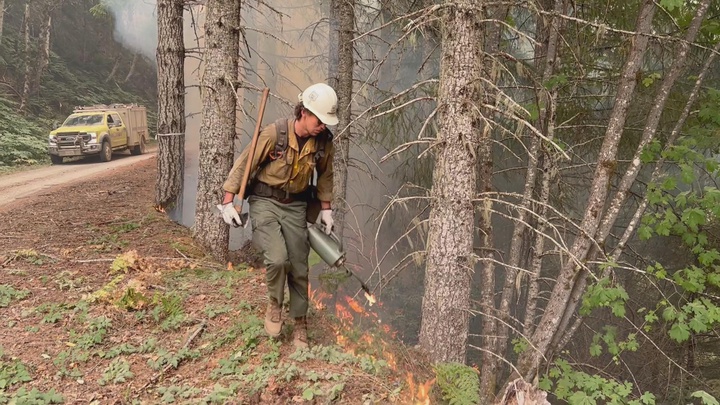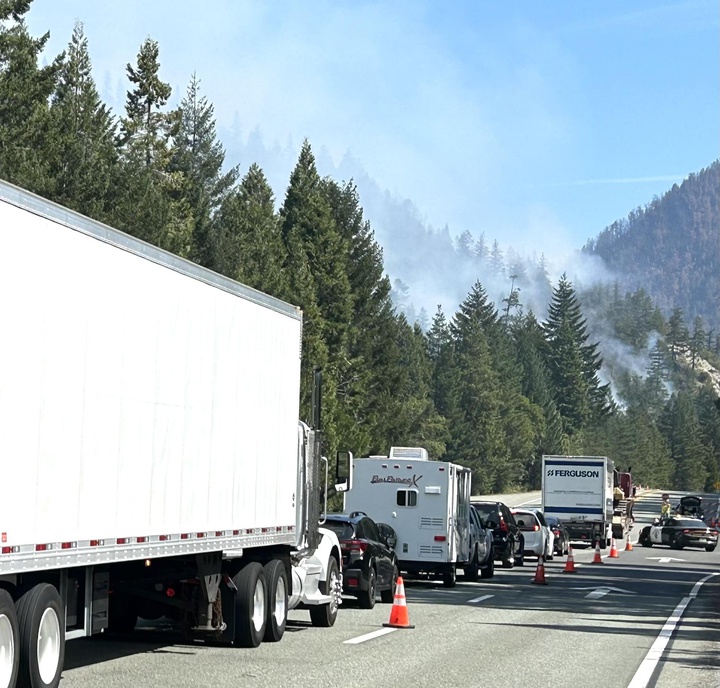Jessica Cejnar Andrews / Wednesday, Sept. 20, 2023 @ 11:57 a.m.
With 100 Percent Fire Containment In Sight, Local Officials Look Small Business Administration, CalOES for Economic Recovery Assistance

A firefighter conducts a "strategic firing operation" on the southeastern corner of the Kelly Fire on Sept. 14. | Photo courtesy of Inciweb
Previously:
With fire crews gaining the upper hand on the Smith River Complex, local officials hope to bring relief to businesses and individuals still struggling to get back on their feet following a five-day power outage and highway closures.
The Del Norte County Office of Emergency Services has begun the process of obtaining a Small Business Development Administration Economic Injury Disaster Loan declaration. Officials are asking business owners to fill out an Economic Injury Disaster Loan worksheet if they have suffered injury, said Emergency Services Manager Deborah Otenburg.
“This is a new process for us and it is very early on in the process,” she told the Wild Rivers Outpost, adding that the injury could come from the fire itself, having to evacuate, the loss of electricity when Pacific Power de-energized its transmission lines or a loss in tourism due to the closure of U.S. 199.
“The county must submit at least five of these worksheets in order to establish that economic injury has taken place to be considered for the program,” Otenburg said.
The Emergency Operations Center command team is also working with the Crescent City-Del Norte County Chamber of Commerce to get updated data on losses businesses and individuals have incurred due to the wildfires. They’re working from a survey the U.C. Cooperative Extension’s Alec Dompka created last month, according to Crescent City Manager Eric Wier.
They will submit those updated results to the California Office of Emergency Services in the hopes they will set up a local assistance center, or LAC, in Del Norte County, Wier said.
“It’ll be a couple of days in which there will be representatives at a specific location, a one-stop location for (businesses) to get all of the information in regard to what assistance is available and who to talk to,” he said. “One of the biggest pieces of this is getting the survey out to people and making sure they have access to it.”
There will also be a survey for individual residents to fill out detailing the losses they have incurred, Wier said. However, at this point, local officials don’t know what resources, if any, would be available to compensate for the loss of food and fuel costs as a result of the power outages, Wier said.

Traffic waits to be escored through the narrows on U.S. 199. | Photo courtesy of Inciweb
“But we do want people to report their individual damage to us so that that can be reported to the state,” he told the Outpost.
According to the results from the Cooperative Extension’s first survey, which was deployed Aug. 26 and analyzed Aug. 30, businesses that responded saw their revenue decline by an average of 53.54 percent compared to the same time last year.
Those businesses reported losing 70 percent of their revenue on average when Pacific Power was forced to de-energize its transmission line on Aug. 18 as a result of the fires. When power was fully restored, businesses still lost 71 percent of their revenue on average, according to the survey.
Across all Del Norte County sectors, 42.11 percent of businesses that responded stated they had to close during the power outage. In the food service and retail sectors, 36.36 percent of businesses closed during the power outage.
In the lodging and camping sectors, businesses that responded to the surveys lost 81 percent of their revenue during the power outage.
The county’s restaurant and retail industry lost $66,578.97 a day since power had been restored, the survey reported, citing combined sales and transiency occupancy tax data.
The lodging sector lost $28,521.69 per day since power was restored. Dompka predicted that if the losses continued at the same rate, the restaurant sector could lose “well over $500,000 from the loss of business alone” by the end of August. Lodging businesses losses would top $250,000 by the end of August, Dompka said in the survey.
On Wednesday, Chamber Executive Director Cindy Vosburg said Dompka was still gathering information from local businesses and individuals and was still compiling data. Vosburg said he hasn’t had a chance to analyze it yet to see how much it’s changed from that initial survey.
“I suspect it probably won’t change a whole lot,” Vosburg said. “But realizing that the road closure was at the peak of the season is devastating for all businesses and that’s going to continue for a number of weeks.”
Vosburg urged businesses and individuals to reach out to the Chamber of Commerce at (707) 464-3174 if they had questions or concerns.
Wier reported on the work the EOC is doing to help businesses and individuals recover from economic impacts to the Crescent City Council on Monday.
The City Council also met Rocky Opliger, representative for California Incident Management Team 4, which took over command of the south side of the fire on Sept. 13.
As of Wednesday, the Smith River Complex had burned a total of 92,914 acres and was 77 percent contained with a total of 1,526 personnel working it.
Opliger told the City Council that crews were focusing much of their attention on the Hurdy Gurdy Fire in the southeastern area of the complex near the Klamath National Forest. They’re using drones to conduct tactical firing operations and are working to minimize the fire’s spread to the east with aircraft and water, he said.
Crews are also working on keeping the fire from spreading south of French Hill, focusing primarily on homes and the community in that area, Opliger said.
Though the Smith River Complex is expected to be 100 percent contained by Oct. 5, Opliger told City Council members that he thinks his crews will have it contained by the end of September.
Crews have begun a suppression repair plan that includes chipping hazardous trees and repairing roads, “starting the road to recovery,” according to a National Forest Service news release.
“You’re going to see a pretty significant reduction (in personnel),” Opliger told the City Council. “We had well over 2,000 when we first got here.”
U.S. 199 is still closed twice daily from 8 a.m.-11 a.m. and from 1 p.m.-4 p.m. Monday through Friday between Madrona and Oregon Mountain Road. During all open hours, including the weekend, a Caltrans pilot car will escort traffic through that stretch of road.
For more information on highway conditions, click here or call (800) 427-7623.
CLICK TO MANAGE